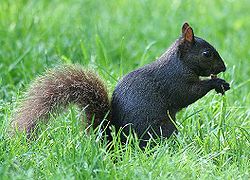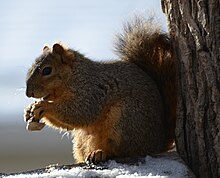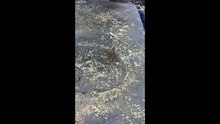Hi Everybody!!
Summer is not quite here, but already the squirrels are stashing nuts! I have the 'squirrel shuffle' down: it is eat 2 and take one to the nest. People once were more like the squirrels in this regard. Summer coming meant get the vegetable garden going and prepare to can veggies and fruits all summer. Jar after jar of jellies, pickles, salsas, tomato sauce for the pantry. As this happened in my lifetime, I just remember lots of work in hot kitchens and gardens. I also remember the reward of the cold winters with a stocked pantry. Just like the old squirrel, I sit in my warm nest with plenty of nuts to munch. So tonight, we celebrate my squirrels in the photostudy and info from the G-Index section. Enjoy!
http://www.definitions.net/definition/squirrel%20away
Definitions for squirrel away
Wiktionary
- squirrel away(Verb)To stash or hide; to hoard, collect, save, or accumulate; to create a reserve, stash, or hoard of some supply, so as to recall a squirrel's burying of nuts.
Citation
Use the citation below to add this definition to your bibliography:
"squirrel away." Definitions.net. STANDS4 LLC, 2013. Web. 27 May 2013. <http://www.definitions.net/definition/squirrel away>.
From my Courtyard:
Red Dumplin is a Red Fox Squirrel (Having a bad tail day!)
They hold the seeds and nuts in the little hand like paws.
This is the hurt squirrel look complete with broken arm. (They all do this)
http://en.wikipedia.org/wiki/Squirrel
Squirrel
From Wikipedia, the free encyclopedia
| Squirrels Temporal range: Late Eocene—Recent | |
|---|---|
| [[file: |240px|alt=]] | |
| Various members of the family Sciuridae | |
| Scientific classification | |
| Kingdom: | Animalia |
| Phylum: | Chordata |
| Class: | Mammalia |
| Order: | Rodentia |
| Suborder: | Sciuromorpha |
| Family: | Sciuridae Fischer de Waldheim, 1817 |
| Subfamilies and tribes | |
| |
Characteristics
Squirrels are generally small animals, ranging in size from theAfrican pygmy squirrel at 7–10 cm (2.8–3.9 in) in length and just 10 g (0.35 oz) in weight, to the Alpine marmot which is 53–73 cm (21–29 in) long and weighs from 5 to 8 kg (11 to 18 lb). Squirrels typically have slender bodies with bushy tails and large eyes. Theirfur is generally soft and silky, although much thicker in some species than others. The color of squirrels is highly variable between—and often even within—species.[4]
The hind limbs are generally longer than the fore limbs, and they have four or five toes on each paw. Their paws include an often poorly developed thumb, and have soft pads on the undersides.[5]The eastern gray squirrel is one of very few mammalian species that can descend a tree head-first. It does this by turning its feet so the claws of its hind paws are backward pointing and can grip the tree bark.[citation needed]
Squirrels live in almost every habitat from tropical rainforest to semiarid desert, avoiding only the high polar regions and the driest of deserts. They are predominantly herbivorous, subsisting on seeds and nuts, but many will eat insects and even small vertebrates.[6]
As their large eyes indicate, squirrels generally have an excellent sense of vision, which is especially important for tree-dwelling species. They also have very versatile and sturdy claws for grasping and climbing.[7] Many also have a good sense of touch, with vibrissae on their heads and limbs.[5]
The teeth of sciurids follow the typical rodent pattern, with large gnawing incisors that grow throughout life, and grinding cheek teeth set back behind a wide gap, or diastema. The typical dental formula for sciurids is 1.0.1.31.0.1.3[citation needed]
The life span of the Gray squirrel is approximately six years. Most urban squirrels do not reach their first birthday. This is due not to predators, but rather to automobiles. Compare this to its rural counterpart, which often perishes from lack of food.[8][dubious ]
Behavior
Squirrels breed once or twice a year and give birth to a varying number of young after three to six weeks, depending on species. The young are born naked, toothless, and blind. In most species of squirrel, only the female looks after the young, which are weaned at around six to ten weeks of age and become sexually mature at the end of their first year. Ground-dwelling species are generally social animals, often living in well-developed colonies, but the tree-dwelling species are more solitary.[5]
Ground and tree squirrels are typically diurnal or crepuscular,[9] while flying squirrels tend to be nocturnal—except for lactating flying squirrels and their offspring, which have a period of diurnality during the summer.[10]
Feeding
Squirrels cannot digest cellulose, so they must rely on foods rich in protein, carbohydrates, and fats. In temperate regions, early spring is the hardest time of year for squirrels, because buried nuts begin to sprout and are no longer available for the squirrel to eat, and new food sources have not become available yet. During these times, squirrels rely heavily on the buds of trees. Squirrels' diets consist primarily of a wide variety of plants, including nuts, seeds, conifer cones, fruits, fungi and greenvegetation. However, some squirrels also consume meat, especially when faced with hunger.[6] Squirrels have been known to eat insects, eggs, small birds, young snakes and smaller rodents. Indeed, some tropical species have shifted almost entirely to a diet of insects.[11]
Predatory behavior has been noted by various species of ground squirrels, particularly the thirteen-lined ground squirrel.[12] For example, Bailey, a scientist in the 1920s, observed a thirteen-lined ground squirrel preying upon a young chicken.[13] Wistrand reported seeing this same species eating a freshly killed snake.[14] Whitaker examined the stomachs of 139 thirteen-lined ground squirrels and found bird flesh in four of the specimens and the remains of a short-tailed shrew in one;[15] Bradley, examining white-tailed antelope squirrels' stomachs, found at least 10% of his 609 specimens' stomachs contained some type of vertebrate, mostly lizards and rodents.[16]Morgart observed a white-tailed antelope squirrel capturing and eating a silky pocket mouse.[17]
The living squirrels are divided into five subfamilies, with about 58 genera and some 285 species.[18] The oldest squirrel fossil, Hesperopetes, dates back to the Chadronian (late Eocene, about 40–35 million years ago) and is similar to modern flying squirrels.[19]
A variety of fossil squirrels, from the latest Eocene to the Miocene, could not be assigned with certainty to any living lineage. At least some of these probably were variants of the oldest basal "protosquirrels" (in the sense that they lacked the full range of living squirrels' autapomorphies). The distribution and diversity of such ancient and ancestral forms suggest the squirrels as a group may have originated in North America.[20]
Apart from these sometimes little-known fossil forms, the phylogeny of the living squirrels is fairly straightforward. The three main lineages are the Ratufinae (Oriental giant squirrels), Sciurillinae and all other subfamilies. The Ratufinae contain a mere handful of living species in tropical Asia. The neotropical pygmy squirrel of tropical South America is the sole living member of the Sciurillinae. The third lineage, by far the largest, has a near-cosmopolitan distribution. This further supports the hypothesis that the common ancestor of all squirrels, living and fossil, lived in North America, as these three most ancient lineages seem to have radiated from there; if squirrels had originated in Eurasia, for example, one would expect quite ancient lineages in Africa, but African squirrels seem to be of more recent origin.[20]
The main group of squirrels also can be split into three subgroups, which yield the remaining subfamilies. The Sciurinae contains the flying squirrels(Pteromyini) and the Sciurini, which among others contains the American tree squirrels; the former have often been considered a separate subfamily, but are now seen as a tribe of the Sciurinae. The pine squirrels (Tamiasciurus), on the other hand, are usually included with the main tree squirrel lineage, but appear to be about as distinct as the flying squirrels; hence, they are sometimes considered a distinct tribe, Tamiasciurini.[21]
Two of the three subfamilies are of about equal size, containing between nearly 70 and 80 species each; the third is about twice as large. The Sciurinae contains arboreal (tree-living) squirrels, mainly of the Americas and to a lesser extent Eurasia. The Callosciurinae is most diverse in tropical Asia and contains squirrels which are also arboreal, but have a markedly different habitus and appear more "elegant", an effect enhanced by their often very colorful fur. The Xerinae—the largest subfamily—are made up from the mainly terrestrial (ground-living) forms and include the large marmots and the popular prairie dogs, among others, as well as the tree squirrels of Africa; they tend to be more gregarious than other squirrels, which do not usually live together in close-knit groups.[20]
- Basal and incertae sedis Sciuridae (all fossil)
- Subfamily Cedromurinae (fossil)
- Subfamily Ratufinae – Oriental giant squirrels (1 genus, 4 species)
- Subfamily Sciurillinae – neotropical pygmy squirrel (monotypic)
- Subfamily Sciurinae
- Tribe Sciurini – tree squirrels (5 genera, about 38 species)
- Tribe Pteromyini – true flying squirrels (15 genera, about 45 species)
- Subfamily Callosciurinae – Asian ornate squirrels
- Tribe Callosciurini (13 genera, nearly 60 species)
- Tribe Funambulini palm squirrels (1 genus, 5 species)
- Subfamily Xerinae – terrestrial squirrels
- Tribe Xerini – spiny squirrels (3 genera, 6 species)
- Tribe Protoxerini (6 genera, about 50 species)
- Tribe Marmotini – ground squirrels, marmots, chipmunks, prairie dogs, etc. (6 genera, about 90 species)
See also
- American red squirrel
- Eastern gray squirrel
- Fox squirrel
- Red squirrel
- Squirrel relationship with humans
- Tree squirrel
- Western gray squirrel
My fave new baby is a gray fox squirrel named Tiny Tim
These peanuts went to the nest!
I hope You enjoyed a look at my squirrels! Now, I like squirrels and I feed them. They are welcome here as it is their Home. I will tell You that some people do not like squirrels (or tree rats). Some of my best secret laughs are due to squirrels. I have seen and known some old men who happen to hate squirrels. Especially squirrels that steal "their" birdseed from the bird feeders. I have seen some pretty strange attempts to outfox the fox squirrels with all kind of contraptions to keep the squirrels off the bird feeders. (No, vaseline on the pole does not work). Dad used to announce that he was not spending his hard earned money on pecans for the squirrels! So every year Mom and I went out and bought pecans and put them in paper bags and say a 'friend' with a pecan tree let us come pick some up. We would fill up the box in the pantry and feed the squirrels all winter with the 'free' pecans and no problems. My Mom loved her birds and squirrels and she was going to feed them. That is just how it was no matter what anyone thought. I have to say that in the end after Dad's stroke, he gave up trying to control the squirrels. I made a feeding station outside his bedroom window so he could see all the life outside. It was a great day when he wanted to get in his scooter and go outside to give a little squirrel a peanut. The power of loving the creatures of Nature is very strong. You never know what encounter is going to wake you up to the big picture of Nature, but in your lifetime something will touch your heart and fix you.
So if you know some of these control freaks, you know the ones: (You must obey me, Do as I say, When I say jump, you say how high-Dads fave- and on and on down to: that squirrel will not eat one more seed from the birds, I'll see to that!); just remember they will get old and not be able to control anything or anyone! Of course, You know I was always cheering for the squirrels when they overcame the barricades set by man! HAHA-
First one to the table this morning!
....this is brendasue signing off from Rainbow Creek. See You next time! Learn from the the squirrels and squirrel away your nuts! Love Ya!
O+O
























No comments:
Post a Comment
Hi Everybody! Please say hello and follow so I know you are here! Due to the inconsideration of people trying to put commercials on my blog comment area, I have restricted use of anonymous posts. Sorry that some hurt all.
My public email is katescabin@gmail.com No spammers or trolls